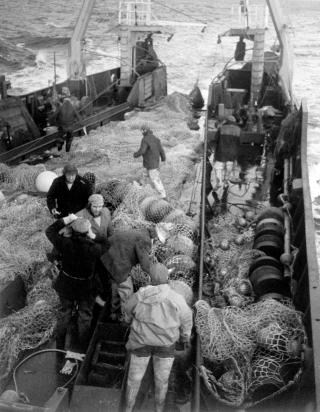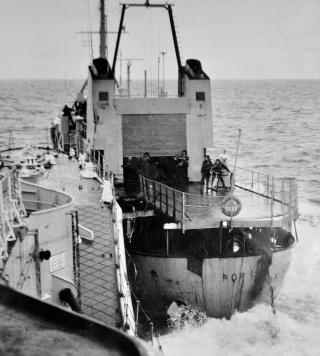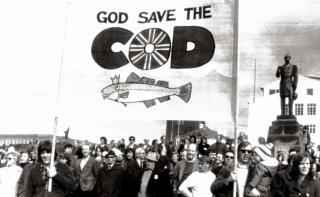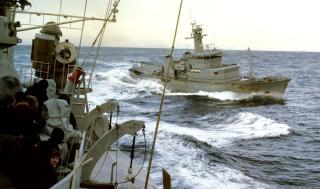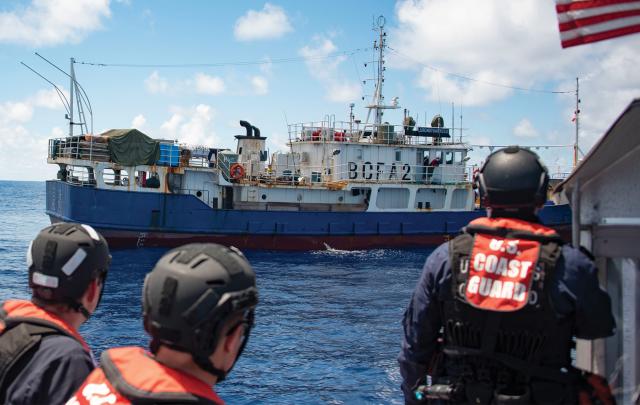Can a small state successfully defend its maritime claims against a nuclear-armed opponent? Are smaller actors able to win below the threshold of high-intensity war? Or was Thucydides right in saying that the strong do what they can and the weak suffer what they must? While pondering these questions, today’s disputes in the South China Sea or future concerns in the Arctic may come to mind. But this saga has played out before, and David bested Goliath when Iceland defeated the United Kingdom in the so-called Cod Wars. This series of intermittent skirmishes between the late 1950s and mid-1970s provides a helpful case study for maritime campaigning.
In a prolonged gray zone conflict such as the Cod Wars, where neither side want to back down but both consider open war unthinkable, all the activities short of war assume increased value and hold greater weight over the conflict’s outcome. Contemporaries regarded the Cod Wars as “one of the most complicated tangles” between two countries, and Iceland’s ability to leverage its power proved decisive for Reykjavik’s success and London’s political defeat.1
Using Iceland’s Cod Wars success as a guide for maritime counterinsurgency, four mutually reinforcing elements factor prominently throughout the conflict: greater national willpower, demonstrated asymmetry of interests, political risk-taking, and innovative nonlethal tactics. The Cod Wars show how smaller states can create escalation dilemmas by incorporating these elements to incrementally shape conditions on the ground and gain ground in the long-term struggle for legitimacy on the global stage.
Background on the Fish Fights
The Cod Wars followed Iceland’s 1952 declaration to increase its territorial waters from three to four nautical miles (nm) after the International Court of Justice recognized similar rights for Norway.2 Disputes over the fishing waters surrounding Iceland go back centuries, but historians generally identify three Cod Wars after 1952: the first, from 1958 to 1961, when Iceland unilaterally extended its fishery limits from 4 to 12 nm; the second, from 1972 to 1973, when Iceland again unilaterally extended its limits to 50 nm; and the third, from 1975 to 1976, when the temporary agreement that had ended the Second Cod War expired and Iceland further extended its limits to 200 nm.
All three conflicts featured sharp political escalation from Reykjavik; passionate rhetoric from all participants; an intense “war of nerves” between Icelandic Coast Guard vessels, British trawlers, and the Royal Navy; and indecision among outside actors on how to respond.3 Substantial economic ties between these two democratic NATO members did not deter conflict, yet only one fatality came from these “wars.”4 Each conflict ended on terms favorable to Iceland, making its victories over the world’s second-most powerful navy all the more intriguing.
National Willpower
Newly independent from Denmark as of 1944, the government in Reykjavik was united and determined to assert its sovereign interests and win its “wars for the territorial waters.”5 It expressed each extension of Iceland’s fishery limits as representing the “common goal of the Icelandic people.”6 Immense national pride and centuries of maritime disputes, coupled with perceptions of neo-imperialism as the Royal Navy sailed into Icelandic waters, pushed Iceland’s population of 300,000 to avoid compromise and resist aggression. Any show of force by London would only validate the grievances from Reykjavik and the population’s determination to extend Iceland’s fishery limits with an “almost religious importance.”7
Despite having its own vocal fishing industry that lobbied for UK escalation in the disputes, London did not have the same national-level captivation with the Cod Wars that Reykjavik commanded. As a result, London lacked the political will to fully leverage its superior naval power and accept the associated political risks.8 Even when the UK won a legal battle, such as a favorable international court ruling shortly before the Second Cod War, London lost the political war of wills.
Fast forward to 2022, and it is clear that questions of national will also extend to maritime disputes or issues related to illegal, unreported, and unregulated fishing. The Cod Wars illustrate the importance of influence and information operations in the maritime domain, something planners in countries less attached to the high seas do not always prioritize.9 To outfight and outlast a determined opponent in a protracted conflict, there can be no substitute for sustained willpower.
Asymmetry of Interests
Deep-rooted economic interests added to Iceland’s motivation to prevail in the Cod Wars. By the Third Cod War, the fishing industry represented 80–90 percent of Iceland’s export earnings, while the passionate UK fishing industry contributed only 1 percent to British GDP.10 Iceland could not survive without cod, and although losing the Cod Wars crippled the British long-distance fishing industry, the struggle was not existential for the UK.11
While Reykjavik had much more to lose economically, London stood to lose more politically as the Cod Wars dragged on and had greater reason to settle. Iceland was not deterred when NATO members objected to its extensions, but growing domestic and international pressure from the United States and NATO ultimately changed London’s calculations on sustaining the conflict.12 The greater power had more to lose and less to gain, so London eventually relented.13
Institutional factors also allowed Iceland to maneuver in ways that the UK could not. With fewer obligations to the international system, Reykjavik appealed to the UN Convention on the Law of the Sea but acted unilaterally when those approaches were unsuccessful. On the other hand, London was limited in escalating militarily because of an array of political considerations and existing norms as a member of the UN Security Council. Although these factors may explain asymmetry to maneuver in some disputes, relying on institutional factors alone faces challenges in accounting for miscalculations or cases in which the larger state harbors revisionist aims.14
Risk-Taking and Cost Imposition
Undergirded with zealous national willpower, Icelandic governments throughout the Cod Wars were emboldened to sharply raise the stakes politically. A complex dynamic arose with Iceland’s entry into a long-term trade agreement with the Soviet Union in 1953, after Iceland first extended its fishery limits to four miles and the UK responded by closing its markets to Icelandic fish imports.15 Reykjavik and Moscow cited the economic benefits as their sole motivation, but Iceland’s status as the first NATO member to have trade ties with Moscow undoubtedly created unease across the alliance. Although both Iceland and the UK were NATO members, Reykjavik used its strategic location and value to NATO as a bargaining chip, threatening frequently to leave the alliance, close the U.S. military base in Keflavik, and jeopardize the alliance’s ability to monitor Soviet submarines and vessels moving south from the Arctic.16
Iceland’s brinksmanship took time to produce effects. Its 1975 move to break diplomatic relations with the UK during the Third Cod War after the Royal Navy again entered disputed waters—which created an unprecedented diplomatic crisis for NATO—finally prompted NATO-led mediation, resulting in the UK withdrawing its warships to allow for diplomatic negotiations to begin.17 Big moves by the small state were necessary to set conditions in the dispute and generate urgency among other stakeholders.
Reykjavik demonstrated astute use of international law when advantageous. As historian Valur Ingimundarson observed, London’s legal argument weakened between the Second and Third Cod Wars when the UK was among those supporting the principle of a 200-mile exclusive economic zone at the Law of the Sea Conference in the summer of 1974.18 Iceland’s legal position further benefited from the United States and Canada’s expansion of their exclusive economic zones, and a team of British and Icelandic scientists in 1975 confirmed Reykjavik’s concerns over the environmental impact of dwindling cod stocks in Icelandic waters. With enduring public support at home and shifting international opinion abroad, Iceland was in position to press its advantages once more, which resulted in the Third Cod War.
Innovative NonLethal Tactics
Beyond political brinksmanship, the Icelandic Coast Guard had to win the contest at sea, and it relied on innovative tactics that the Royal Navy failed to counter. Necessity was the mother of invention for Iceland to compete without a navy, and chief among Iceland’s innovations were trawlwire cutters introduced during the Second Cod War.19 After warning a suspected foreign trawler in Icelandic waters, the Icelandic Coast Guard would sail its vessels at right angles to the trawler with net cutters in tow and cut the trawler’s wires, leaving their fishing nets adrift. A cat-and-mouse game ensued, during which UK and West German fishers would conceal their ships’ names and colors, sail in pairs to deny Icelandic Coast Guard ships easy access to their fishing wires, or even ram the Icelandic gunboats to persuade their captains to change course. 20
The net cutters proved highly effective and created dilemmas for UK trawlers and the Royal Navy. As Mark Kurlansky wrote, “A trawler without a trawl had nothing to do but go home.”21 With 35 recorded uses during the Third Cod War, Iceland’s “Lilliputian fleet” developed a solution more fit for the challenge than the Royal Navy’s strategy to amass overwhelming maritime power and compel Iceland’s acquiescence.22 Foreign fishers would leave empty-handed and incur significant time and financial costs as a result. No show of force could recoup or offset those losses and may have invited criticism over a disproportionate use of force.
Iceland’s strategy mirrored what recent commentary suggests is viable for coastal states fighting an expeditionary navy near its shores: not seek to establish command of the sea, but instead deny unimpeded access to opponents.23 Creative approaches with Iceland’s small craft and use of nonexplosive munitions raised costs of business for UK ships through maintenance costs or risks of boarding and impoundment by Icelandic authorities. Even with the Royal Navy deploying as many as 37 ships at the peak of the Cod Wars, they were ill-suited for close-in maneuvering to counter the Icelandic Coast Guard and faced mounting costs as the increased ramming of Icelandic boats took their physical toll.24
The Icelandic Coast Guard demonstrated that the right strategy is more important than relying on lethality, especially for conflicts short of declared war. The UK ultimately lost the battle at sea because the Royal Navy and UK fisheries could not adjust, even when their numbers and conventional capabilities looked superior on paper.
Propaganda also played an important role. Shaping the narrative was crucial to amplify Iceland’s position and wear down London’s opposition in the court of global public opinion. Icelandic diplomats seized on the UK’s use of Nimrod jets to monitor Icelandic gunboats and insinuated that the UK was neglecting its NATO obligations.26 Iceland’s student diaspora similarly worked to influence host governments and organizations to withhold business from British fisheries.27 Accusations of British imperialism played well in Scandinavia and West Germany, giving some legitimacy to Iceland’s grievances while stymying political support for the UK.
In Cod We Trust
As security experts scrutinize the Russo-Ukrainian war and other hotspots, one common theme is the significance of the will to fight and resist coercion. Without the will to fight, human-centric counterinsurgency approaches on the high seas will be dead in the water. But if willpower is there, Iceland’s example shows that innovative statecraft and operating concepts hold considerable implications for maritime campaigns, and that firepower is not the sole deciding factor. Taken together, these elements of Iceland’s campaign were essential for victory against a larger foe in the Cod Wars and provide lessons for small states facing larger competitors in current and future scenarios.
1. Gudni Thorlacius Johannesson, “Troubled Waters: Cod War, Fishing Disputes, and Britain’s Fight for the Freedom of the High Seas, 1948–1964” (dissertation, University of London, 2007), 13.
2. Fisheries Case (United Kingdom v. Norway), 18 December 1951, ICJ 3.
3. Guðmundur J. Guðmundsson, “The Cod and the Cold War,” Scandinavian Journal of History 31, no. 2 (2006).
4. Sverrir Steinsson, “Do Liberal Ties Pacify? A Study of the Cod Wars,” Cooperation and Conflict 53, no. 3 (September 2018).
5. English translation of Landhelgisstríðin, Iceland’s term for the Cod Wars. The contrast in terminology reflects the seriousness with which Iceland’s population viewed the conflict.
6. Guðmundsson, “The Cod and the Cold War.”
7. Johannesson, “Troubled Waters,” 197.
8. Walker D. Mills, “The Cod Wars and Lessons from an Almost War,” Center for International Maritime Security, 28 July 2020.
9. Kevin Bilms, “What’s in a Name? Reimagining Irregular Warfare Activities for Competition,” War on the Rocks, 15 January; and Erika De La Parra Gehlen and Frank L. Smith III, “Advantage at Sea Requires Rethinking Influence,” War on the Rocks, 5 March 2021.
10. R. P. Anand, “The ‘Cod War’ Between the UK and Iceland,” India Quarterly 32, no. 2 (April–June 1976).
11. Matthew Jarrett, “The Cod Wars,” Forgotten History, February 2021; “The View from Grimsby,” The Economist, 25 April 2015; and “The Cabinet Papers: The Cod Wars,” The National Archives.
12. Steinsson, “Do Liberal Ties Pacify?”; and Sverrir Steinsson, “Why Did the Cod Wars Occur and Why Did Iceland Win Them? A Test of Four Theories,” (master’s thesis, University of Iceland, June 2015).
13. George Friedman, “War and the Asymmetry of Interests,” Geopolitical Futures, 18 April 2018.
14. Robert Jervis, Perception and Misperception in International Politics: New Edition (Princeton, NJ: Princeton University Press, 2017); and Lim Kheng Swe, Ju Hailong, and Li Mingjiang, “China’s Revisionist Aspirations in Southeast Asia and the Curse of South China Sea Disputes,” China: An international Journal 15, no. 1 (February 2017).
15. Guðmundsson, “The Cod and the Cold War.”
16. R. P. Gibson, “The Infamous Cod Wars,” Medium, 16 November 2020; and Scott Savitz, “Mind the Gap,” The RAND Blog, 15 July 2021.
17. Valur Ingimundarson, The Rebellious Ally: Iceland, the United States, and the Politics of Empire 1945–2006 (London: Republic of Letters, 2011).
18. Valur Ingimundarson, “Fighting the Cod Wars in the Cold War: Iceland’s Challenge to the Western Alliance in the 1970s,” The RUSI Journal 148, no. 3 (2003).
19. Hannes Jónsson, Friends in Conflict: The Anglo-Icelandic War and the Law of the Sea (London: Hurst & Co., 1982).
20. Mark Kurklansky, Cod: A Biography of the Fish that Changed the World (New York: Penguin Books, 1998).
21. Kurklansky, Cod: A Biography of the Fish that Changed the World.
22. Ingimundarson, “Fighting the Cod Wars in the Cold War”; and Johannesson, “Troubled Waters,” 164.
23. B. J. Armstrong, “The Russo-Ukrainian War at Sea: Retrospect and Prospect,” War on the Rocks, 21 April 2022.
24. “The Cod Wars,” British Sea Fishing.
25. Guðmundsson, “The Cod and the Cold War.”
26. Guðmundsson, “The Cod and the Cold War.”


